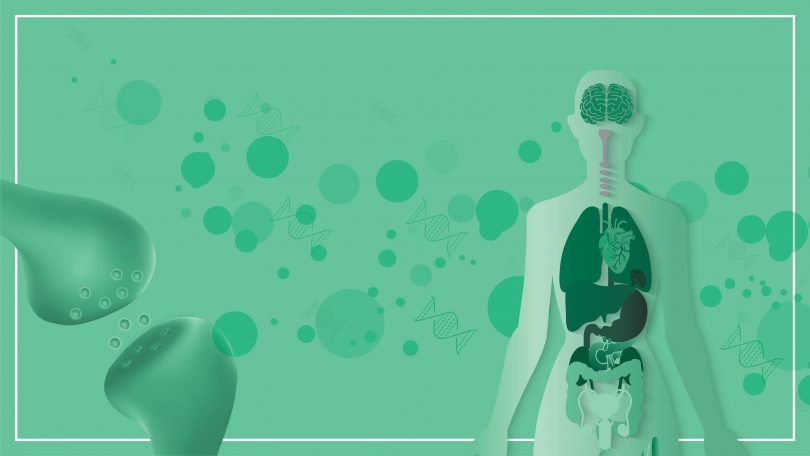Cannabis has been pinned as a treatment option for many different disorders lately, many of them seeming completely unrelated. Everything from physical pain to mental disorders and even cancer are said to respond to cannabinoid treatments, but how exactly is that possible?
When you first start hearing about all the different conditions that medicinal cannabis is being used for these days, it almost seems like a gimmick to legalize. Can one plant, not to mention it’s a plant that gets you high, seriously have so many therapeutic benefits? Although it may seem like a stretch, if you have an understanding of the Endocannabinoid System, it makes a lot more sense why cannabis actually works so well in the human body.
CBD Testers Are Wanted!
Subscribe
What is the Endocannabinoid System?
The only reason cannabis actually works and has an effect on us at all is because of the Endocannabinoid System (ECS). Simply put, the ECS is a network of receptors that exists in the bodies of all mammals, plus the endocannabinoids that bind to them. As a whole, the ECS regulates numerous different functions and processes in our bodies and maintains internal balance and homeostasis.
Researchers have discovered two different endocannabinoids so far, 2-arachidonoylglycerol (2-AG) and anandamide (AEA). 2-AG is made from omega-6 fatty acids and is present in fairly high levels in the central nervous system, but it has also been detected in human (and bovine) milk. 2-AG is a full agonist of both the CB1 and CB2 receptors, but it has a stronger influence over the CB2 receptor. Because of this, 2-AG is thought to have a substantial impact on the immune system.
Anandamide (AEA), also commonly referred to as the “bliss molecule”, is believed to play a major role in the in all of our basic daily physiological functions including sleep/wake cycles, appetite, mood, and even fertility; but we’ll get more in-depth on the benefits of this cannabinoid a bit later.
In addition to the naturally produced cannabinoids, there is also a large web of receptors that allow AEA and 2-AG to function the way they do. The two receptors that have been studied most extensively are CB1 and CB2. Cannabinoid receptors sit on the surface of cells and monitor conditions on the outside. Once they sense changing conditions and the body falling out of a state of homeostasis, they signal the appropriate cellular response to restore balance.
Anandamide: The Bliss Molecule
Although there are two known endocannabinoids, one is by far more prominent in research and literature: Anandamide (AEA). The reason AEA is known as the Bliss Molecule is because of the role in plays in balancing our body functions and elevating our moods. Multiple studies have been conducted on the benefits of being exposed to varying levels of anandamide.
Anandamide – The “Bliss” Molecule of the Endocannabinoid System
In 2015, a study examining both humans and rodents, found that high levels of anandamide contributed to mood elevation and fear reduction. When the enzymes that break down anandamide were inhibited, the subjects felt less fear and anxiety where threats were perceived.
A 2009 study linked anandamide to fertility by showing that high levels of this endocannabinoid were not only beneficial, but essential for regular ovulation and proper fetal development. The study also concluded that higher levels of anandamide during times of ovulation contributed to a healthy and successful pregnancy.
A slightly older study published in 2004 found that increased levels of anandamide the bloodstream created a “euphoric high” in people who had just performed rigorous exercise or physical activity. This is frequently described as a “runner’s high” or “adrenaline high”, and it’s likely the reason why people who use cannabis often feel that it contributes to their workout.
Although this is one of the more studied cannabinoids, there is still a lot that remains unknown about the bliss molecule the extent of its functions.
Clinical Endocannabinoid Deficiency
Clinical endocannabinoid deficiency is a recently discovered condition, some might call it a theory still, in which the body doesn’t produce enough endocannabinoids. As a result, the body becomes unbalanced leading to the onset of numerous different diseases and disorders.
According to acclaimed cannabinoid researcher Dr. Ethan Russo, people who are diagnosed with a clinical endocannabinoid deficiency can benefit tremendously by supplementing with phytocannabinoids – cannabinoids coming from plants.
Are You Suffering From Clinical Endocannabinoid Deficiency?
“Migraine, fibromyalgia, irritable bowel syndrome and related conditions display common clinical, biochemical and pathophysiological patterns that suggests a clinical endocannabinoid deficiency that may be suitably treated with cannabinoid medicines,” Russo mentioned in his 2004 study. This research has been reviewed and echoed a couple times over the years, in 2014 and 2016.
The above conditions have the greatest evidence of being caused by a clinical endocannabinoid deficiency, however, there is an extensive and varied list of disorders that are likely related to this condition. These include neonatal failure to thrive, cystic fibrosis, causalgia, brachial plexopathy, phantom limb pain, infantile colic, glaucoma, dysmenorrhea, hyperemesis gravidarum, unexplained repetitive miscarriages, post-traumatic stress disorder, bipolar disease, and the list continues.
Neurological disorders have also been linked to a lack of natural endocannabinoids. Some experts believe that Alzheimer’s disease, Parkinson’s disease, and similar disorders can be treated with cannabinoids. This could be why people suffering from these conditions report success when self-medicating with cannabis products.
Final Thoughts
When you look at the whole picture, and realize how integrated cannabinoids are within almost every system in our bodies, it makes perfect sense why cannabinoid-based therapies are so successful at treating so many different conditions. The Endocannabinoid System has a role in all of our basic body functions, so if you’re feeling out of balance, can’t eat right, can’t sleep, suffering from anxiety, etc., the right blend of cannabinoids might be more effective than chemical pharmaceuticals at relieving your ailments and symptoms.
Thanks for stopping by CBDtesters.co, where we’re covering everything related to medical cannabis and legal cannabis business. Stop back frequently and subscribe to the Medical Cannabis Weekly Newsletter to keep yourself up-to-date.








Good job on the article about the Endocannabinoid system.
CBD is able to increase anandamide amount in our body, thus making us happy and less anxiety. Thanks for the studies mentioned in this article.